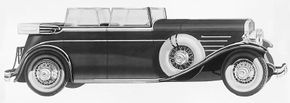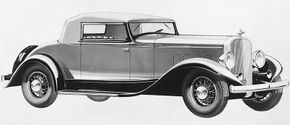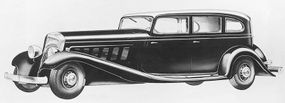Franklin has the special distinction in being one of the few U.S. automakers to achieve real success with air-cooled power. It was featured on the very first Franklins of 1902, which immediately won a reputation for high quality and innovation that would carry on right to the end of the company in 1934.
Weight-saving construction received particular emphasis. In an age when cast iron was the standard stuff of engine blocks, pistons, and cylinder heads, Franklin used high-grade, light-weight aluminum. At one time, Franklin was the world's largest consumer of aluminum. Equally unusual were the cars' all-around full-elliptic springs, which provided a smoother ride and much reduced tire wear than most competitors' half-elliptic suspensions.
Advertisement
A flexible wood frame also softened the ride. By 1920, other advanced technical features such as full-pressure lubrication, automatic spark control, and electric choke were long-familiar Franklin fare. So too were six-cylinder engines; Franklin abandoned fours after 1914.
Franklin's commitment to "aircooling" got a boost when Charles A. Lindbergh made his historic transatlantic flight in 1927. After all, the Spirit of St. Louis had an air-cooled engine, and Franklin advertising eagerly pointed up the parallel. The company then began using the name "Airman" on some 1928 models to honor the Lone Eagle. All Franklins that year adopted four-wheel Lockheed hydraulic brakes and a steel chassis. Standard "silent second" synchromesh was further innovation for 1929.
Like many Detroit producers, Franklin entered the '30s with optimism despite Wall Street's recent, ominous crash. That was understandable. The company had enjoyed record sales in 1929, and interest in both aviation and air-cooling was at an all-time high.
Reflecting Franklin's rosy outlook was its 1930 line of "145" and "147" models with new styling and power on respective wheelbases of 125 and 132 inches. Both were announced by a handsome new radiator, which Franklin always termed a "hood front," believing that a conventional radiator was essential to sales. This now had shutters governing the amount of incoming air, with shutter opening controlled automatically by a thermostat connected to the number-one cylinder.
Per company tradition, the new engine had six individually cast cylinders and overhead valves, but differed in having cooling air directed to the sides of the block from left to right -- an arrangement soon known as "side-blast" cooling. The six delivered 95 horsepower from 274 cubic inches.

Franklin had always been a luxury make, so its chassis were a logical basis for many custom bodies, typically by Derham, Dietrich, Locke, and Brunn. Among the more memorable 1930 open styles was Dietrich's four-door Pirate, available as either a five-passenger phaeton or seven-seater touring. Its most striking feature was running boards fully concealed by flared door bottoms.
Also new that year was the Pursuit, a dual-cowl phaeton that lacked external door handles in the interest of cleaner appearance. Upholstery in the Pursuit's front compartment wrapped up and over the outer edge of the doors a la aircraft cockpits of the day.
Dietrich also conjured a popular four-door, four-seat speedster with an abbreviated body ending midway over the rear wheels. Most of these were closed styles with permanent canvas tops, but a full-convertible option was offered at extra cost.
As you might expect, famous pioneer aviators like Lindbergh, Amelia Earhart, and Frank Hawks chose Franklins as their personal cars, something else the company was only too eager to publicize. But though Franklin had its sporty models, it never sold cars on that basis. Most of its customers were physicians, attorneys, business executives, and other professionals, so paint colors were usually conservative and blackwall tires were the norm.
Franklin was ahead of the industry by selling more sedans than open cars before 1920, and sedans remained the models of choice in the '30s. Franklins may thus be described as conservative, elegant, and fairly expensive. The owners were loyal, and Franklin had many repeat customers.
For more on defunct American cars, see:
- AMC
- Duesenberg
- Oldsmobile
- Plymouth
- Studebaker
- Tucker
Advertisement


